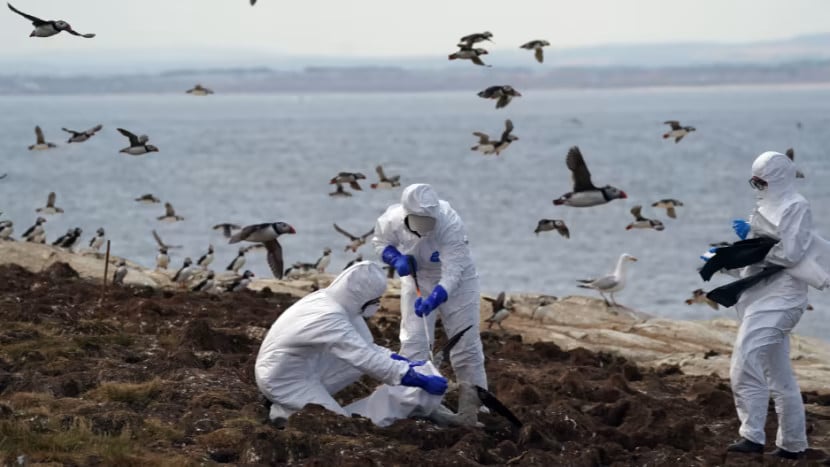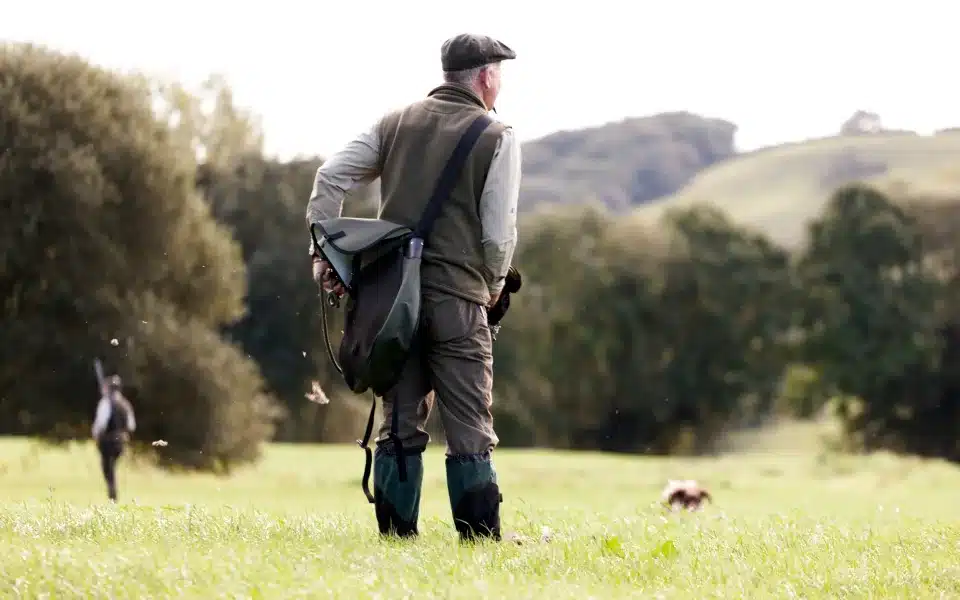Last week Yahoo News reposted a Daily Telegraph puff piece for the shooting industry which ran with the headline, “Gamekeepers face ruin after last-minute change to licences.”
Lamenting a normally supine government for actually (finally) recognising the terrible threat of Avian Flu to wild bird populations and that protected areas ought to be – you know, protected, the industry weeps (with one dry eye firmly fixed on the Telegraph’s gun-owning and bird-shooting readership) about a “chaotic” decision to change licencing rules at the 11th hour, “just as partridges and pheasants are about to be released and after tens of thousands of pounds has been spent preparing for the season”.
So a few operators won’t get to make money by selling birds to shooters? Well, excuse us while we reach for the world’s tiniest violin to play a lament for this extractive and exploitative industry. Boo hoo.

Protected areas? In name only.
Can anyone other than a shooting lobbyist (or Telegraph journalist) seriously find even the teeniest shred of sympathy for a “Nigel Neame, secretary of the Bulford and Tidworth Garrison Shoot”, quoted in the Telegraph and whose shoot was among those told this week that “it was being denied a licence to release birds on the protected area on the Salisbury Plain” (pictured above).
Some of us may be a little numbed by thirteen years of continual attacks on the environment, on biodiversity, on rivers and coasts, but it’s hard to imagine even after so much softening up that the public would rally around a shoot that has been stopped from releasing thousands of non-native birds onto one of the most important grassland areas in Europe just so that they can be shot at by a bunch of hobbyists with guns?
Just floating something here, but as a general rule, shouldn’t Special Areas of Conservation and Sites of Special Scientific Interest alive with rare invertebrates and plants, be given the sort of protection that legislation and common sense demands? We are after all one of the most nature-depleted countries on the entire planet. It’s surely reasonable to demand that at the very, very least shooting should spend an hour or two asking for a license to kill wildlife on some of the most important landscapes in the UK.
And these are very important places indeed. The Telegraph helpfully lists ‘Special Protection Areas where shoots have been told to apply for licences’. They include the North York Moors, the North Pennine and South Pennine Moors, the Peak District, Dartmoor, Bowland Fells and of course Salisbury Plain.
Just think about that for a second. Rather than whining about the collapse of hundred-year-old shoots, up until 2023 the shooting industry has been so unregulated that it hadn’t even needed a licence to kill vast amounts of wildlife in what are laughingly called ‘national parks’ and Areas of Outstanding Natural Beauty!
Rather than acknowledge that the public would rather not risk witnessing birds exploding in a puff of feathers as they hike through some of England’s most beautiful countryside, we’re supposed instead to nod along sagely as shooting lobbyists BASC yet again challenge any threat to shooting’s profits, while bemoaning the ‘fact’ that “the legal process would take months, by which time many of the shoots in Special Protection Areas (SPA) will have folded”.

Avian Flu
As if tipping literally millions of birds into protected (and highly stressed) environments wasn’t bad enough, the article also quotes a spokesperson from Defra (the normally rabidly pro-hunting, pro-culling and pro-shooting government department that browbeats the general public into accepting whatever it has been told by a succession of lobbyists parading through the revolving doors fitted to its offices) who says without exaggeration:
“We are currently experiencing the worst global outbreak of avian influenza on record and are taking all necessary steps to mitigate the impact and spread of the disease.”
Avian flu ripped through populations of wild birds in 2022 and was still rife in seabird colonies in the spring. A July 4th ‘bird flu’ update published by Defra warned that “Whilst the risk level in kept birds has reduced, the risk in wild birds remains high and all bird keepers should continue to take steps to prevent bird flu and stop it spreading at all times and be vigilant for signs of disease.”
However, despite Defra’s unusually proactive and precautionary approach, shooting (if we’re to believe the Telegraph) seems to think that because things aren’t quite as bad as they were it should be allowed to pursue a business-as-usual model.
The article quotes a shoot owner who sells birds to be blasted out of the sky in the Brecks:
“We followed all the extra restrictions that the Government put in place in 2021 on the number of birds we could release on an SPA and in the 500m buffer zone and we thought it was done, but now they have decided to move the goal posts again without any warning and whilst avian flu is declining…Where we are in East Anglia was one of the worst areas for bird flu last year…we saw dead geese and dead seagulls, but it didn’t impact the pheasants.”
Yes, in shooting’s peculiarly tone-deaf and self-centred world, regulations are always temporary, the industry should always be the first to know, and science should never get in the way of anecdote.

Shooting’s unlikely poster boys: the gamekeepers.
Perhaps even the shooting industry recognises that a headline saying ‘Shooting industry fights regulations that protect biodiversity and wild birds because they stand to lose money’ won’t fly. Hence feeding the Telegraph’s journalist an alternative headline: “Gamekeepers face ruin after last-minute change to licences”?
Aiming to position gamekeepers as shooting’s public face is – well, risky to put it mildly (as the photo above of the repellent Alan Wilson, a Scottish gamekeeper convicted of killing protected animals, amply proves).
Back when kings and the ‘nobility’ stole as much land as they could grab and turfed everyone else off it, they employed an especially brutal militia to literally crush anyone daring to try to feed themselves from the countryside: gamekeepers.
Renowned for carrying cudgels and savagely beating up anyone they found ‘trespassing’, gamekeepers were the paid thugs of wealthy estate owners. It’s an attitude that hundreds of years later saw gamekeepers take on the Kinder Mass Trespassers in the 1930s, and which still sees gamekeepers following hikers on moorland in ‘national parks’.
Historically it has been the focused attention of gamekeepers that has wiped huge areas of Great Britain clean of birds of prey. That pushed the Scottish Wildcat, the Polecat, the Pine Marten and even the Red Squirrel close to extinction.
The main role of a gamekeeper on a shooting estate has always been to keep the ‘game’ bird population up and to maximise the profits gained from shooting parties (as a Times newspaper sub heading once put it, “Gamekeepers say their livelihoods depend on there being enough birds to shoot“). That means doing the dirty work of shooting, trapping and snaring literally hundreds of thousands of animals which might eat grouse, pheasants, or their eggs.
Persecution by gamekeepers is ongoing of course. Just check that list of ‘protected areas’ again. Almost every one of them is renowned as wildlife crime hotspots. Bowland, the Peak District, the Pennine Moors, all of them scarred by relentless raptor persecution. These are areas where shooting estates dominate and areas where Hen Harriers, Goshawks, Red Kites, Short-eared Owls, Common Buzzards et al routinely ‘disappear’. The Yorkshire Post even once printed a list of SIXTEEN individual raptor persecution incidents between January 2018 to July 2020 under the heading ‘North Yorkshire – a black hole for raptors‘.
And who is responsible for all this wildlife crime?
As we (and the RSPB) note time after time, it is shooting estates and gamekeepers. Check out the ‘raptor persecution’ category on our news pages.
Yet the Telegraph article pitches gamekeepers as objects of sympathy. Asking us to empathise, as a shoot owner wants us to do, with a man whose day job is killing wildlife by describing him being “on the phone in tears” because “he has worked so hard for this season” doesn’t cut it.
No, it’s yet another attempted deflection. There may be tears, but the Telegraph will have to work a lot harder to convince many of us that gamekeepers aren’t blubbing in the corner about ‘hard work lost’ but growling in rage and frustration that Defra has stopped them from seeing ‘their birds’ being blasted out of the sky in the autumn.
End Shooting
Entitled, hubristic, oblivious to the carnage it causes, underpinned by wildlife crime, and seemingly living in a parallel world where wildlife is nothing more than a cash cow, the shooting industry really doesn’t seem to get how the vast majority of people who don’t kill wildlife for fun sees it. That’s what will undoubtedly bring them down one day.
And when that happens? Well, listen carefully and you might just about pick out the sound of that teeny-tiny violin again.
-
Protect the Wild wants to shut down the shooting industry, the blanket term we use to describe everything from shooting estates (where commercial shooting largely takes place), to gamekeepers (who are responsible for the birds that estates rear to be shot), shooting syndicates (groups that rent a shoot and use membership subscriptions to fund the operation of a shoot) and shooters themselves (the clients who go to estates or are syndicate members who pay to shoot birds). It’s a bold aim, but click here to find out how we intend to do it.

